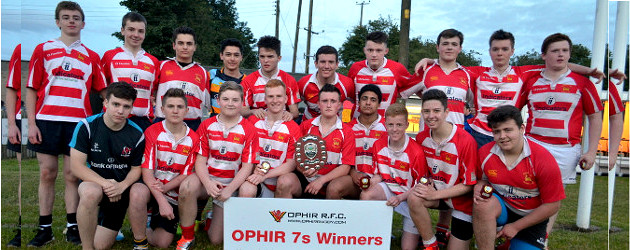The UUC RFC weekly Tag Rugby Tournament got of to a great start today (18-04-12). The tournament is open to every student at Coleraine Uni from all walks of life and sports, female and male. It is none contact and is played in the very best of lightheartedness and fun, as each team has a maximum of 7 players with 1 female. This week G-Force’s team won the tournament with Rebbecca Smyth claiming player of the tournament by scoring more points than any other player. If you would like anymore if email UUC Rugby Development Officer Jamie Ball Rugby@uucrfc.com
A Quick 20 Step Guide to the Offical Rules
However these maybe altered to suit different pitch sizes and teams, but the basics are identical!
1. How many players in a team? – There is a maximum of seven (7) players
per team on the field at any one time from a squad of twelve (12). In
mixed or social games there must be a minimum of three (3) players of the
opposite sex (subject to local rules) on the pitch at all times. Rolling subs
are allowed at any time during the game but in mixed/social games the
appropriate number of each sex must be maintained.
2. How long are matches? – This is subject to local rules but the normal
duration of a match is two halves of twenty (20) minutes each, with a five
(5) minute interval for half time. For festival type events, matches normally
consist of two seven (7) minute halves with one (1) minute for half time.
3. Players clothing – All players wear either the official TAG Rugby match
shorts or, a TAG Rugby belt. Shirts should be tucked in at all times.
The tags (ribbons) must be properly positioned on either side of the hips.
No player can participate in the game without both tags being properly in
place.
Players are not allowed to wear anything that might prove dangerous to
other players, e.g. any jewellery & watches.
4. How do players score in TAG Rugby? – There is only one way of
scoring in TAG Rugby and that is by scoring tries. A try is awarded to the
attacking team when they touch the ball down on the ground on, or over,
the try-line. A try is worth one (1) point but to encourage more team play,
in mixed games, a try is worth two (2) points if scored by a female.
5. Are there any scrums or line-outs? – There are no scrums or line-outs in
TAG Rugby.
6. Is there any kicking allowed? No kicking is allowed in TAG Rugby,
except for a modified kick at kick offs (see below for further details).
7. Can you bash into other players? – There is strictly NO CONTACT
allowed between players; both attackers and defenders have a
responsibility to avoid each other at ALL times. The ball carrier is not
allowed to run directly into defenders and defenders are not allowed to
block the progress of the ball carrier. No hand-offs, or using your hand,
elbow or ball to block or shield your tags (ribbons) in any way is allowed.
No pulling of clothing or pulling/knocking the ball out of the ball carrier’s
hand is permitted. Any player that initiates contact should be penalised.
“Run at spaces not faces”
8. How do you ‘tackle’ (tag) in TAG Rugby? – Only the ball carrier can be
tagged and a ‘tackle’ (‘tag’) is simply the removal by a defender of one of
the two tags (ribbons) from the ball carrier. The defender then holds the
tag above his/her head and shouts “tag” for all to hear. An attacking team
has 4 “tags” or “plays” to score. If a 5th tag is made a changeover occurs
and the defending team is given possession of the ball and restarts play
with a tap & go.
9. What happens after a ‘tackle’ (tag)? – After a tag has been made the
game then comes to a temporary halt; the defender drops the tag on the 4
ground, marking the position where the actual tag took place, and the
game restarts with the attacker who was tagged taking a roll-the-ball from
this mark.
10. What is a roll-the-ball? – A roll-the-ball takes place after a tag has been
made. At a roll-the-ball the tagged ball carrier must return to the location
where the actual tag took place. Play restarts when this player rolls the
ball back between his/her legs, using his/her hand, to a team-mate
standing directly behind him/her, the scrum-half. Only after rolling the ball
back, should the attacker pick up and re-attach his/her tag and he/she is
then able to rejoin the game.
A roll-the-ball cannot be taken any closer than five metres (5m) from the
try-line.
11. What must the defensive team do at a roll-the-ball? – At a roll-the-ball
the defensive team must retire back a minimum of seven metres (7m), or
until they have reached their own try-line if this is nearer. One defender
may choose to act as a ‘marker’. ‘Markers’ are optional. The ‘marker’ must
stand directly in front of a roll-the-ball and cannot move or interfere with
play until the ball is back in play.
12. What is the rule about carrying the ball in two hands? – To
encourage more passing and to avoid the ball carrier deliberately, or
instinctively, trying to protect his/her tags, the ball carrier MUST, when
they are within three metres (3m) of defenders, HOLD THE BALL IN
TWO HANDS.
13. What is a tap & go? – A tap & go is used to start the game or restart it
at the place the ball went out of play or an infringement or changeover
took place. The ball may be placed on the ground or held in the hand and
on the instruction “play” by the referee, and not before, the attacker must
tap the ball with the foot, or lower leg, to restart play. At a tap & go the
opposition players must retire back seven metres (7m) towards their own
try-line, or until they have reached their own try-line if this is nearer. 5
A tap & go cannot be taken any closer than five metres (5m) from the tryline.
14. What happens to the tag count at a tap & go? – When a tap & go is
awarded the number of tags (Tag Count) starts back to zero. This is a
good incentive for the defensive team not to deliberately infringe.
15. What is off-side? – Defending players are only ever off-side if they have
not moved back the required seven metres (7m) to the defensive line, or
until they have reached their own try-line if this is nearer, at a roll-the–ball
or tap & go situation.
Attacking players are only off-side if they are in front of the ball at a tap &
go or roll-the-ball situation. There is no off-side in open play.
16. When should players be penalised for being off-side? – Players
should only ever be penalised for off-side if they are Off-SIDE AND
INTERFERING WITH PLAY. If players find themselves accidentally offside they must make every effort to get back on side; but if they are in no way interfering with play, then they should not be penalised and play
should be allowed to continue. Players who are off-side are temporarily
out of the game.
17. How quickly can a tap & go and roll-the-ball be taken? – A tap & go
cannot be taken quickly but only after the referee has given the defensive
team time (about five seconds) to retire the required seven metres (7m)
and given the instruction ‘play’. A roll-the-ball can be taken quickly and as
soon as the ball carrier is on the mark of the tag and ready to do so.
18. Can players dive to score? – There is no diving allowed to score a try
or to secure a loose ball on the floor; instead, players must remain on their
feet to play the ball.
19. How do you kick off? – A modified place kick is used to start each half
and restart play after a try is scored. The team that has scored kicks-off
The ball must be placed flat on the ground at the centre of the half-way
line. Kicking tees are not permitted and no player may hold the ball
upright. The ball, when kicked, must travel a minimum of 7 metres (7m)
forward but not above the referee’s waist height. Defending players must
retire back 7 metres (7m) whilst players of the team kicking off must be
behind the ball when it is kicked. The ball must not be kicked so it travels
over the try line, or goes directly into touch without bouncing.
Note: If playing on soft sand where it would be difficult to properly execute
this type of place kick then the kick-offs and restarts are replaced by an
punt kick which the defending team must be allowed to catch uncontested.
20. What happens when somebody does something wrong? – Whenever
the TAG Rugby rules are broken, a tap & go is awarded to the nonoffending team at the place the infringement took place and the number of tags (Tag Count) starts back to zero. If the infringement took place over
the try-line, or within five metres (5m) of it, the tap & go is awarded five
metres (5m) out from the try-line to create some space.
Note: If an infringement took place by the attacking team at a kick off then
the defending team are awarded a tap & go at the centre of the half-way
line.
Code of conduct
All players and coaches will be expected to abide by the rules of the
tournament and decisions made by the officials and referees. They will
be expected to play fairly and demonstrate good sportsmanship both
on and off the pitch. In the event of misconduct and/or repeated and
deliberate breaking of the rules or dangerous play, then the
referee/tournament officials shall, at their discretion issue players with
a red or yellow card.







